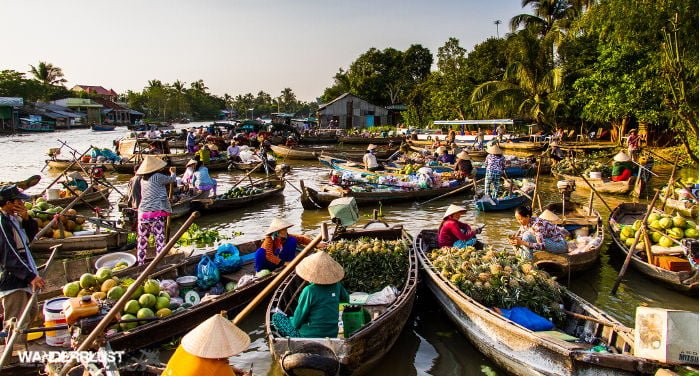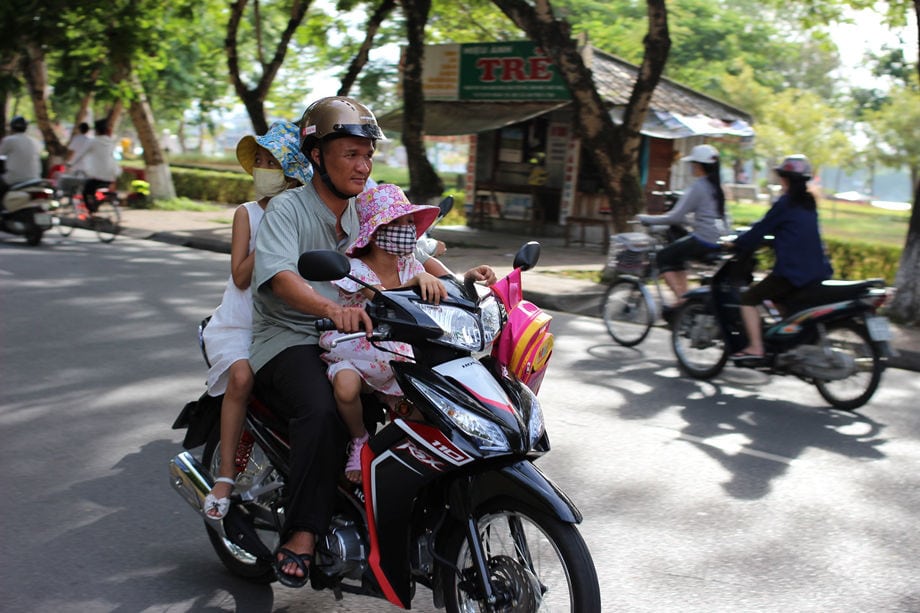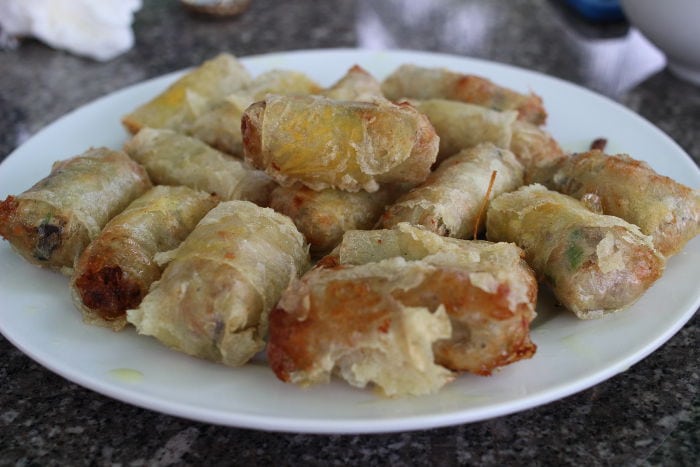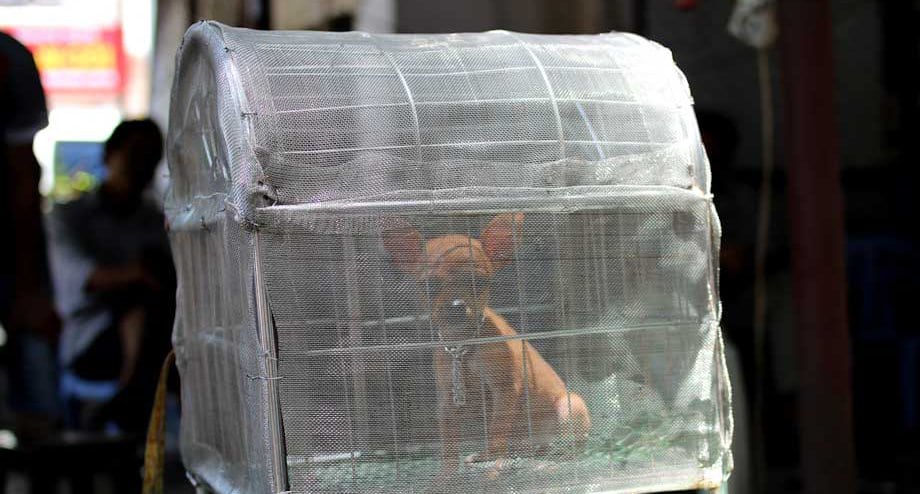
The eleventh longest river in the world, and one of the longest in all of Asia, the Mekong is certainly the most important in ex Indochina. The famous river starts in Tibet and, after crossing more than 4,000 kilometers through six countries – China, Myanmar, Thailand, Laos, Cambodia and Vietnam, it empties into the South China Sea.
The Mekong is called “Cuu Long Ciang” by the Vietnamese, or the “River of the Nine Dragons”, a definition of the eight estuaries of its delta. After doing some reading, I discovered that the number eight is an unlucky number in Vietnam, and for this reason a dragon was added to its definition.
The dragon, a mythological creature that’s revered in Vietnam, symbolizes size and strength; in this area the watercourses are an important source of life, both for transporting merchandise of all types and for agriculture. For this reason the river is likened to a dragon.
How to get to the Mekong Delta
The Mekong Delta is located between Cambodia and Vietnam. The last part of the Mekong is located in southern Vietnam, where the local population lives closely tied to the river.
Navigation along its entire length isn’t easy; in some sections it’s impossible due to currents, dams and water flow depending on the season.
If you land in Vietnam, the closest international airport is the one in Ho Chi Minh City, from which you can take a bus.
You can also get to Phnom Penh, the capital of Cambodia, via bus or the river by a cruise or any type of boat. Don’t expect crystal clear waters! Chau Doc is instead the crossing point between the borders of Cambodia and Vietnam. From here you can get on a boat or speedboat along the Mekong toward Phnom Penh.
From Cambodia the river branches off to Vietnam and its mouth and delta with its nine estuaries – or dragons, as I said above.
Note that you can also take a cruise leaving from Laos or Thailand (always through Phnom Penh).
If you decide to travel through various countries, first make sure that you have all necessary visas (or know how to get them along the way).
Unmissable places along the Mekong Delta
When it comes to staying on the Delta, you could opt for a one, two, or multi-day cruise along the Mekong. To visit all places you’ll need many days, but for a few days I recommend the following places:
- Can Tho, the largest city along the Delta;
- Cai Be, where you can visit the floating market (one of the largest markets in all of Vietnam) and the colonial French cathedral;
- Ca Mau, where you’ll find the “U Minh” natural park, a marvelous reserve far from mass tourism;
- Long Xuyen;
- If you’re a fan of history and want to increase your knowledge, I recommend the city of Vinh Long, which offers museums about the war in Vietnam and also a few interesting temples.
3 day itinerary from Ho Chi Minh
Here’s an excellent itinerary:
- Day 1: Leave from My Tho, located 70 kilometers from Ho Chi Minh City, to start your cruise on the Mekong; arrive at the island of Thoi Son among the tropical orchards; bike excursion on the island of Ngu Hiep to understand the local life; sunset on the Mekong;
- Day 2: The following day I recommend a visit to the Cai Be floating market on the Mekong and artisanal factories; visit the Vinh Trang Pagoda (the largest and oldest in the region);
- Day 3: The last day, you can continue your tour on the Mekong among green oases and villages before heading toward the north of the country or return to Ho Chi Minh City.
You can also opt for a half day visit.
What’s there to see along the Mekong Delta?
Along the Mekong Delta you’ll have a unique experience among green oases and villages, excursions to discover the people that live along the banks of the river and subsist on fishing or floating agriculture, junks, pagodas and sampans – the typical wooden boats – that go back and forth and constitute the most frequent form of transport and communication.
The floating markets
The Mekong Delta is the area in southeast Asia where you can more fully enjoy this wonderful tradition directed toward nature. There are in fact countless boats that you’ll come across, along with products and the people that live there, who besides navigating the river for commercial purposes, have made their floating market their reason for living.
The Cu Chi Tunnels
Since you’re in this part of Vietnam, I recommend that you also go visit the Cu Chi Tunnels: this is a network of tunnels and underground alleys that were able to host up to 10,000 soldiers, where during the war against the Americans, Vietnamese soldiers hid and took refuge to rearm and surprise American troops.
Unfortunately, the refuge was discovered and bombed, but since then it was restored. Here you can directly immerse yourself in the 60’s through galleries that were 80 centimeters wide, 1.2 meters high, and about 220 kilometers long.
The crops
Besides cultivating rice, you can see plantations of rubber, juta, cotton, tabacco, coffee, pepper, coconut palms and sugar palms.
Where to stay on the Mekong Delta?
If you decide to take a long cruise, you can sleep on board or in one of the villages mentioned: there are lots of families ready to host you and give you their heart and soul.
Curiosities
If you’ve seen Apocalypse Now, the film directed by Francis Ford Coppola in 1971 about the Vietnam War, you’ll certainly remember the scenes where Captain Benjamin Willard (Martin Sheen) goes back to the Nung River, on his search mission for Colonel Kurtz (Marlon Brando). Although it was filmed in the Philippines, that river was in reference to the Mekong.
Photo Credits: ![]() Can Tho Floating Markets 12 by Hugh Derr
Can Tho Floating Markets 12 by Hugh Derr



